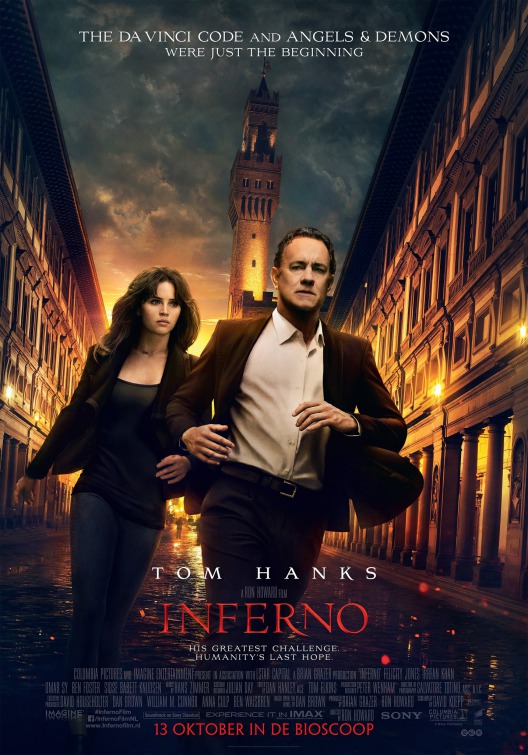His Greatest Challenge. Humanity’s Last Hope.
Director
Ron Howard
Starring
Tom Hanks
Felicity Jones
Ben Foster
Sidse Babett Knudsen
Irrfan Khan
Omar Sy
Side-stepping Dan Brown’s literary release following The Da Vinci Code (The Lost Symbol) Inferno was published in 2013 and immediately put into production for a film adaptation, reprising Tom Hanks in the role of symbologist, author, history buff, professor and shitty Indiana Jones, Robert Langdon. Since his exploits with the Catholic Church, Langdon awakes in a hospital with a gunshot wound to the head which has caused extreme hallucinations, memory loss and crippling headaches. He quickly ascertains he is no longer in America having been admitted to a hospital in Florence, Italy. The doctor looking after him is Sienna Brooks [Jones] who barely has time to discuss his case before an assassin posing as a policewoman starts shooting at the confused professor. From here on, Langdon tries to retrace his steps and figure out what’s happening with the assistance of a compliant Sienna – ticking the series requirement of having Langdon team up with another brunette European sidekick. He slowly learns that billionaire and bioscientist Bertrand Zobrist [Foster] has created a virus which will kill half of the world’s population but has thankfully left clues as to the virus’ location using the writings of Dante. Hot on their tails are the World Health Organisation, bursting into private residences with guns drawn and a shady company called The Consortium, who are partly responsible and feel kinda bad for it. But who will get to the virus first? What motivations are guiding the various components? Will Langdon get his memory back and remember the word for coffee? Only Ron Howard and this incredibly drab feature have the answers!
The first thing to address is that Inferno seems to be populated with two tiers of acting: charming and wooden. It should be noted that I said “acting” not “actors;” some of the worst performances are given by individuals who have proven themselves more than capable in other releases. Hanks, Foster and Khan are far and away the most endearing (if that’s the right word) individuals but everyone else seems to be largely ridiculous, delivering lines with minimal gusto, believability or commitment. And a film like this heavily relies on selling the nonsense-speak through charming performances which ensure you don’t question the glaring stupidity or convenience of, frankly, the entire plot and/or setting. To that end, I can see the appeal of these stories, there’s an element of schlocky escapist fun traveling around the world, dodging assassin’s bullets, trying to save the day but the poor execution (both in terms of the source material and the film itself) hinder any significant or lasting enjoyment.
**in order to discuss the differences between the novel and the film, there are heavy spoilers throughout this section**
As a bookseller, many years ago, I hated The Da Vinci Code with a passion. Laughably stupid, badly written yet somehow insanely popular. The film had to bring a loyal adaptation to the screen and inherited every awful flaw. The follow-up film, Angels & Demons, strangely worked for me mostly because it made deviations from the book and ended up a semi-pleasing thriller. Inferno also makes key alterations to plot and characters but – and I can’t believe I’m saying this – the book sort of handles it better. The big twist of the film is that Sienna is not all she seems, turning out to be Zobrist’s lover and accomplice. Turns out she’s just as much a loon as he is and the puzzle to the whereabouts of the virus was all for her. This also takes place in the book but the book twists again and effectively says “not really, she’s a good guy.” Thankfully, the film sticks to its guns and commits to Sienna being a villain through-and-through. Where the book trumps the film, however, is to do with the virus itself. In the film Sienna must find the virus (in a bag beneath the Hagia Sophia in Istanbul) and trigger explosives to detonate it and infect everyone in the vicinity. It’s dumb and ultimately thwarted. In the book, however, Sienna, Langdon and the WHO learn that the virus was in a soluble bag and dissolved a week prior; the date in Zobrist’s video is not that of when the virus would start spreading but when it will have reached the entire population. The idea that the chase was for nothing and the conversation about sterilising a third of the planet (the virus has different effects in the book and the film) is an extremely interesting talking point; one the book fluffs, granted but the film lazily side-steps it entirely, opting for a simple, very anticlimactic, neat ending.
You would think taking the time to work through the book, streamlining the story and altering characters would resolve any potential narrative issues, instead, it seems to have created more plot holes than usual. To keep up the pace and tension, the film amalgamates characters and drops the charade angle, meaning the supposed threat to Langdon’s life becomes real. But from an audience perspective, it simply appears that the Consortium has a very real problem with rogue agents constantly betraying their bosses to vaguely “sell the virus to the highest bidder”. Then there’s Langdon’s priest friend, Ignazio Busoni who helps Langdon steal Dante’s death mask from a museum but dies? I think? I don’t remember it being addressed but he doesn’t turn up outside of hallucinatory visions and security footage. And that’s before we address the standard problem of these films which grants Langdon unhindered access to every museum and holy place and that all these clues are put in place to justify having clues. The logic of why one would go to the lengths they do for a glorified treasure hunt is baffling and simply sets yourself up to fail. At least in Angels & Demons the chase was intentionally misdirectional, manipulating those involved and the audience, diverting attention away from the real intention. Here it seems an exercise in futility.
But the film isn’t all bad – despite valiant efforts to the contrary. Hans Zimmer’s established themes still work well, Salvatore Totino’s camera work is decent enough (as it has been with all of his previous Ron Howard collaborations) but the execution of the visions of hell is a point of contention. In truth, it’s not badly made, it’s just boring. A thriller jet-setting across the Mediterranean with a time limit to save the world should be compelling and thrilling, hooking the audience and creating an emotional investment. Instead we end up with a flat foray through key tourist destinations accompanied by a smattering of historical tidbits. A complete waste of time and talent that will hopefully prove the final nail in the coffin for this franchise.
Release Date:
14th October 2016
The Scene To Look Out For:
**spoilers at the end**
Thinking back on the film, almost nothing sticks out in my mind. For better or worse, the first two instalments in this series made a lasting impression but Inferno is such a bland release that even with the star budget, exotic locations and competent crew, the final product is so horribly forgettable. If I had to talk about one scene, it’d be the moment Sienna reveals she’s working in league with Zobrist. To date I’ve not been especially impressed with Felicity Jones but at a time when she narratively had the opportunity to really turn her acting style on its head, nothing stood out. I could see she was going for a manic, wide-eyed moment of revelation as she turns and slams the subterranean grate shut but quickly reverted back to her normal self. Shame.
Notable Characters:
Khan is probably the only individual who comes out of this film unscathed, somehow managing to give an interesting and entertaining performance. Playing the role of Harry Sims, head of the nefarious organisation Consortium, Khan is mysterious, in-charge but sufficiently deft with a blade making him a fairly interesting individual. More than that, his performance is given with the same level of charm that Hanks naturally exudes, elevating tiresome dialogue to an almost witty rapport.
Highlighted Quote:
“Yes. Anagram.”
In A Few Words:
“Much like its predecessors, Inferno is tied to incredibly weak source material that drags it down but there’s no visible fight to produce something of note, as if hobbling along, accepting its mediocre fate”
Total Score: 2/5
![The Red Right Hand Movie Reviews [Matthew Stogdon]](https://reviews.theredrighthand.co.uk/wp-content/uploads/2021/12/cropped-header1.png)




